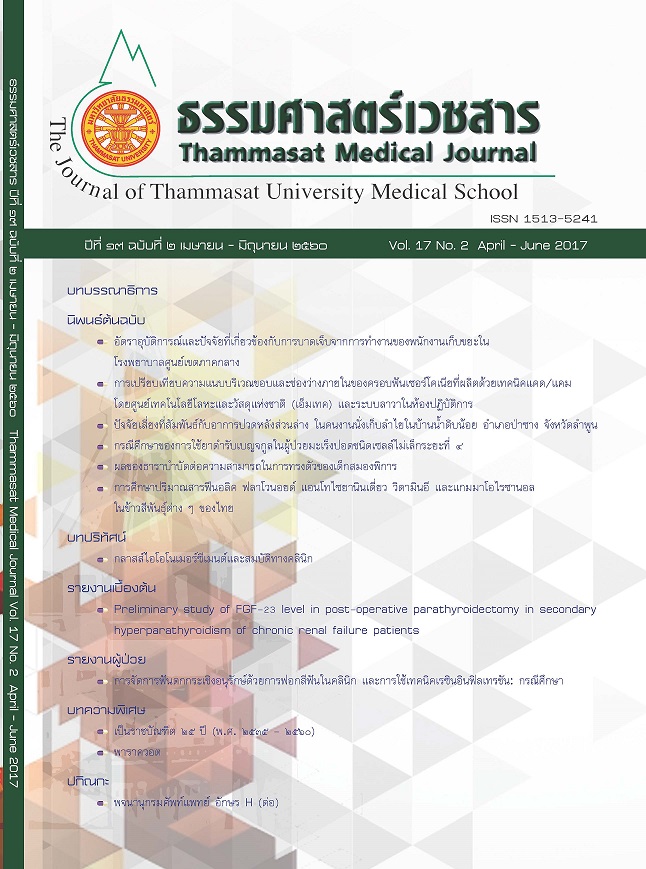A comparison of marginal fit and internal gap of MTEC and Lava CAD/CAM zirconia crowns, in vitro
Keywords:
แคด/แคม, ช่องว่างภายใน, ความแนบบริเวณขอบ, ครอบฟันเซอร์โคเนีย, CAD/CAM, Internal gap, Marginal fit, Zirconia crownAbstract
Introduction: The National Metal and Materials Technology Center (MTEC), Thailand was recently introduced the dental computer aided design and computer aided manufacturing (CAD/CAM) zirconia ceramic. The important factor for the success of the restoration is marginal and internal gap. Therefore, the aim of this study was to compare marginal fit and internal gaps of zirconia coping made by MTEC and LavaTM system.
Method: 40 upper first premolars were prepared for zirconia crowns and randomly assigned to either MTEC or LavaTM system, 20 each. CAD/CAM zirconia substructures were fabricated and cemented with corresponding tooth. To assess the marginal and internal fit, the cemented zirconia substructures were sectioned buccolingually and mesiodistally. Seven gap reference points (2 points of marginal gap, 2 points of axial internal gap and 3 points of occlusal internal gap) of each surface of section were evaluated under stereomicroscope (80X).
Result: The mean ± S.D. for the marginal fit, axial internal gap and occlusal internal gap were: 96.06 ± 28.85, 77.38 ± 26.13 and 234 ± 67.61 μm for MTEC group, and 85.51 ± 36, 61.99 ± 16.57 and 211.42 ± 89.65 μm for LavaTM system.
Discussion and Conclusion: T-test showed no significant differences between groups for marginal fit and occlusal internal but there was significant differences between groups for axial internal gap.
บทนำ: ศูนย์เทคโนโลยีโลหะและวัสดุแห่งชาติ (เอ็มเทค) ประเทศไทยพัฒนาการผลิตเซรามิกเซอร์โคเนียที่ออกแบบและผลิตด้วยระบบคอมพิวเตอร์ (แคด/แคม) เพื่อใช้ในงานบูรณะฟัน ปัจจัยสำคัญหนึ่งที่มีผลต่อความสำเร็จของวัสดุบูรณะคือความแนบบริเวณขอบและช่องว่างภายใน ดังนั้น งานวิจัยนี้มีวัตถุประสงค์เพื่อเปรียบเทียบความแนบบริเวณขอบและช่องว่างภายในของแกนครอบฟันเซอร์โคเนียกับฟันหลัก โดยศึกษาครอบฟันเซอร์โคเนียที่ผลิตโดยเอ็มเทคและระบบลาวา
วิธีการศึกษา: เตรียมฟันกรามน้อยบนซี่ที่ ๑ จำนวน ๔๐ ซี่ สำหรับครอบฟันเซอร์โคเนียแล้วสุ่มแบ่ง กลุ่มละ ๒๐ ซี่ เป็นกลุ่มเอ็มเทค และระบบลาวา แกนฟันเซอร์โคเนียจะถูกผลิตด้วยเทคนิคแคด/แคมและยึดเข้ากับฟันหลัก แล้วตัดแกนฟันเซอร์โคเนียที่ยึดแล้วในแนวใกล้แก้มใกล้ลิ้น และใกล้กลางไกลกลางเพื่อวัดความแนบบริเวณขอบและช่องว่างภายใน โดยวัดช่องว่างที่ ๗ ตำแหน่งอ้างอิง (ช่องว่างบริเวณขอบ ๒ ตำแหน่ง ช่องว่างภายในของบริเวณแกนฟัน ๒ ตำแหน่ง และช่องว่างภายในบริเวณด้านบดเคี้ยว ๓ ตำแหน่ง) จากแต่ละด้านที่ถูกตัดภายใต้เครื่องสเตอริโอไมโครสโคป (๘๐ เท่า)
ผลการศึกษา: ค่าเฉลี่ย ± ส่วนเบี่ยงเบนมาตรฐาน ของความแนบบริเวณขอบ ช่องว่างภายในของบริเวณแกนฟัน และช่องว่างภายในบริเวณด้านบดเคี้ยวของแกนครอบฟันที่ผลิตด้วยเอ็มเทค เท่ากับ ๙๖.๐๖ ± ๒๘.๘๕, ๗๗.๓๘ ± ๒๖.๑๓ และ ๒๓๔ ± ๖๗.๖๑ ไมโครเมตร และระบบลาวา เท่ากับ ๘๕.๕๑ ± ๓๖, ๖๑.๙๙ ± ๑๖.๕๗ และ ๒๑๑.๔๒ ± ๘๙.๖๕ ไมโครเมตร
วิจารณ์ และสรุปผลการศึกษา: จากการทดสอบสถิติค่าทีไม่พบความแตกต่างอย่างมีนัยสำคัญทางสถิติของความแนบบริเวณขอบ และช่องว่างภายในบริเวณด้านบดเคี้ยวระหว่างกลุ่ม แต่พบความแตกต่างอย่างมีนัยสำคัญทางสถิติของช่องว่างภายในของบริเวณแกนฟันระหว่างกลุ่ม



